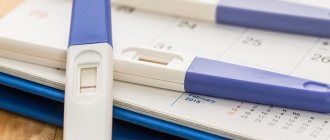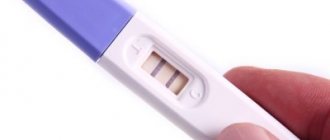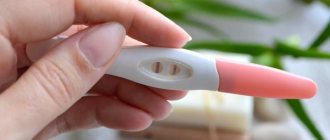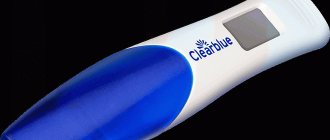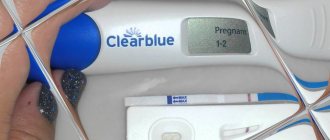How do pregnancy tests work?
Absolutely all pregnancy tests check whether there is a special Pregnancy Tests hormone in the urine or blood (if we are talking about a laboratory test) - human chorionic gonadotropin, abbreviated as hCG. It begins to be produced immediately after the fertilized egg attaches to the wall of the uterus.
If there is no pregnancy, hCG has nowhere to come from. If it is there, hCG will definitely be present.
Typically, the egg attaches to the uterus six days after fertilization. There is no point in doing a test during this period: it will not show anything. But then the hCG level increases quickly, doubling every 2-3 days.
Links
- Marina Solovyova.
[www.womenclub.ru/gynecology/1026.htm Pregnancy tests]. womenclub.ru (March 2, 2013). [www.webcitation.org/6JEO3k2C8 Archived from the original on August 29, 2013]. - [sibmama.ru/index.php?p=hgch_povishenie Pregnancy tests. Questions and answers] - sibmama.ru
- [mame.org.ua/kak-pravilno-polzovatsya-testom-na-beremennost/ What are the types of pregnancy tests] - mame.org.ua
| There is a more complete Pregnancy test article in another language section. You can help the project by expanding the current article with translation. |
When to take a pregnancy test
Already 8 days after ovulation, during which the egg meets its sperm, the level of hCG becomes sufficient for pregnancy to be confirmed using a laboratory blood test.
In a few more days - that is, on the 10th-12th day after fertilization - the pregnancy will be detected by ordinary pharmacy tests.
Although the instructions for many of them promise an accurate result already on the first day of the delay, doctors advise not to rush Home pregnancy tests: Can you trust the results? . The reason is simple.
If you ovulate on the 10th–14th day of your cycle, then by the beginning of the next cycle at least 13 days will have passed since fertilization. This means that the test will signal you with two stripes.
However, ovulation may shift. If the egg was released on the 22nd day of the cycle, then by the beginning of the delay the actual gestational age may be less than 7 days. This means that even perfect tests will most likely not capture anything.
If your cycle is more or less than 28 days, things are even more confusing.
Therefore, in order to get the most accurate result, you should wait 5–7 days from the start of the delay.
If you are pregnant, the hCG level by this time will in any case be such that even the cheapest tests with low sensitivity will clearly recognize it
But even if you met all the deadlines, the test can still mislead you. For example, it will not see a high level of hCG and will show a negative result if there is an existing pregnancy, or, on the contrary, it will give two stripes, although it does not smell like pregnancy. To be fair, let’s say that it’s not so much the test that’s to blame for this, but you yourself. Five reasons for false-positive pregnancy tests.
Operating principle
To determine pregnancy, the level of the hormone hCG (human chorionic gonadotropin)[2][3] is measured and urine or blood is analyzed. After fertilization of the egg and the formation of the chorion (future placenta), the concentration of hCG in the blood doubles daily, the highest level occurs at week 20, then gradually decreases. A rapid increase in the level of hCG in the blood is observed on days 7-8 after conception. In urine, the level of hCG during pregnancy on the first day of missed menstruation is 25-100 mIU/ml, while in non-pregnant women it is less than 5 mIU/ml [2].
Home tests are qualitative, not quantitative - they determine the level of hCG that is greater or less sensitive than the test, so errors are possible[2].
The most accurate data on the presence of pregnancy and its expected duration is provided by a laboratory analysis of the level of hCG in the blood. Enzyme immunoassay of venous blood determines the exact level of the hormone (at the time of blood sampling)[2].
Starting from the second week of delayed menstruation, the fetus can be recognized by ultrasound scanning when the size of the fertilized egg is more than half a centimeter [2].
Why do rapid pregnancy tests lie?
You used an expired or damaged test
Express tests contain special highly sensitive substances that react to hCG levels. It is they who, when in contact with the urine of a pregnant woman, are painted with a bright second stripe or plus sign.
But if the test is expired or improperly stored, the sensitivity of these substances may decrease. As a result, they will give a negative result, which may turn out to be false.
What to do
Buy tests only in pharmacies, where, unlike supermarkets, they try to provide them with the correct storage conditions. When purchasing, be sure to check the expiration date.
You bought a test with low sensitivity
The sensitivity of rapid tests is indicated by numbers - 10, 20, 25, 30. These numbers indicate the concentration of hCG in urine (in mIU/ml) that they are able to detect. The higher the number, the less accurate the test. The most expensive and accurate options have a sensitivity of 10. But cheap ones may not detect hCG and deceive you by showing a negative result.
What to do
When purchasing a test, be sure to check with your pharmacist how sensitive it is. Also, this information can often be found on the packaging and always in the instructions.
You took the test this afternoon
It’s not for nothing that in the instructions for the vast majority of tests, the manufacturer talks about morning urine. It is more concentrated, there is more chorionic gonadotropin in it, which means the test will be more reliable.
In the afternoon, the content of hCG in the urine is lower.
What to do
Use the test exclusively in the morning, as the manufacturer instructs.
Did you drink a lot of water before taking the test?
Water dilutes the urine, which lowers hCG levels. The rapid test may not detect the hormone and give a false negative result.
What to do
Try not to eat or drink anything before the test.
You didn't look at the results in time
The instructions for each test stipulate the rules for its use. For example, like this: “The result can be assessed 4–5 minutes after the test, but no later than 15 minutes.” These minutes were not taken out of thin air.
The lower limit indicates the time it takes for the test to allow the sensitive substances it contains to react to the hCG level. If you look at a test earlier than the agreed upon date, the second line (or the plus sign in the corresponding window) may not yet appear and you will see a false negative result.
If you look at the strip after the time indicated as the upper limit, you risk getting a false positive result. Evaporated urine may leave a line that can easily be confused with the second line.
What to do
Before using the test, read the instructions and follow them strictly.
You are taking certain medications
Some diuretics and antihistamines affect the composition of urine, diluting it. This reduces the level of hCG, which means there is a risk of getting a false negative result.
Other drugs, on the contrary, can give you two stripes, although in fact there is no pregnancy. Such medications include:
- some tranquilizers and sleeping pills;
- anticonvulsants;
- drugs that enhance fertility.
What to do
If you are taking any medications on this list, you should not rely on a paper rapid test. To determine whether you are pregnant or not, do a laboratory blood test.
you are sick
If there is increased blood or protein in the urine, this may also affect the result of the rapid test. But it is important to note that this situation in itself is extremely unhealthy. Blood in the urine indicates problems with the bladder or kidneys; increased protein indicates internal inflammation.
Therefore, most likely, the erroneous two stripes on the test will be accompanied by increased temperature and/or discomfort in the genital area and kidneys.
What to do
Do not rely on a rapid test if you have a fever and pain in your lower back or lower abdomen. In case of such ailments, you should contact a therapist, gynecologist or urologist as soon as possible so as not to miss a serious illness.
You develop an ovarian tumor
Some types of tumors can trick the test into showing two lines.
What to do
Once you receive a positive result, do not delay your visit to the gynecologist. The doctor will conduct research during which he will determine the actual duration of pregnancy (if any) or send you for additional tests and to specialized specialists.
Accuracy
Systematic review published by[ whom?
] in 1998, shows that a pregnancy test administered at home by experienced people is almost as accurate as laboratory testing (97.4%). However, when it is used by ordinary consumers, accuracy drops to 75%: the reviewers noted that most users did not understand or follow the instructions included in the kit. Improper use can lead to both false negative and false positive results.
How to take a pregnancy test correctly
- Read the instructions. And follow it, of course!
- Remember the rule: if you are healthy and the test shows a positive result, the probability of pregnancy is 99%. A negative result may be false up to a week after the delay.
- Choose tests with a high level of sensitivity. 10 is ideal.
- Do the test in the morning, not in the afternoon, and especially not in the evening.
- Try not to drink at least an hour before the test.
- Do not rely on the test if you are taking the medications listed above or if you have fever or lower abdominal pain.
- Buy two tests at once so you can double-check the results.
- If rapid tests contradict each other, don't wonder what's wrong. Get a laboratory blood test to get a reliable result.
Important! A positive test, even if you have been waiting for it for a long time, is, alas, not yet a reason to rejoice. An increased level of hCG in the urine can also be recorded during an ectopic or frozen pregnancy. Therefore, after receiving two strips, go to the gynecologist as soon as possible.
Cast[edit | edit wiki text]
- Tom Hanks as Chesley "Sully" Sullenberger, US Airways Flight 1549 crew chief
- Aaron Eckhart as Jeffrey Skiles, co-pilot of US Airways Flight 1549
- Laura Linney as Lorraine Sullenberger, wife of Chesley Sullenberger
- Anna Gunn - Dr. Elizabeth Davis
- Autumn Reaser - Tess Soza
- Anne Cusack as Donna Dent, flight attendant on US Airways Flight 1549
- Holt McCollaney - Mike Cleary
- Mike O'Malley - Charles Porter
- Jamie Sheridan - Ben Edwards
- Jerry Ferrara - Michael Delaney
- Molly Hagan as Doreen Welsh, flight attendant on US Airways Flight 1549
- Max Adler - Jimmy Stefanik
- Sam Huntington - Jeff Kolodjei
- Wayne Bastrap - Brian Kelly
- Valerie Mahaffey - Diana Higgins
- Jeff Kober - L.T. Cook
- Katie Couric - cameo
- Captain Vince Lombardi - cameo
- Noelle Fink - Emma Cowan
Common tests
The most popular test is a strip test, on which pregnancy is indicated by two stripes, and its absence by one. Specific antibodies to hCG are applied to the colorless second strip of the test. If at the time of the test in the woman’s urine its concentration is high enough, the area with the applied antibodies becomes stained and a second strip appears [2].
Most tests are designed for hCG concentrations in urine above 25 mIU/ml, which is enough to find out about pregnancy on the first day of the delay. As a rule, from the fifth day of delay in the normal course of pregnancy, such a test shows a “positive” result as soon as urine gets on the strip [2].
There are more sensitive tests, they react to 10 mIU/ml and show pregnancy 3-4 days before the date of expected menstruation[2].
Testing with a home rapid test is best done in the morning, when the concentration of hCG is maximum. Before the test, you should avoid drinking a lot of fluids and diuretics. The test may fail if you have an irregular menstrual cycle, diabetes insipidus, or other characteristics of the body. It is also necessary to strictly follow the instructions and check the expiration date of the test[2].
When testing, it is possible to obtain false positive and false negative results.
Possible reasons for a false positive result (the test shows a positive result in the absence of pregnancy)[2]:
- taking medications containing hCG;
- the presence of tumors and other pathologies of the female reproductive organs;
- spontaneous termination of pregnancy;
- a small number of days after the abortion.
Possible reasons for a false negative result (the test shows a negative result in the presence of pregnancy)[2]:
- the test was performed prematurely, irregular menstrual cycle;
- diabetes insipidus, kidney pathology and other diseases in which hCG is less excreted in the urine;
- large intake of fluids or diuretics before testing;
- an expired test or failure to follow the instructions, in particular, the strip was not inserted deep enough into the urine.
Notes
- ↑ 1 2 Katerina Arkharova.
"The men thought it was immoral."
history of the invention of the pregnancy test (Russian). BBC
(18 May 2019). Retrieved May 19, 2020. - ↑ 1234567891011
Martirosova. - Tests for determining pregnancy in the early stages are reliable assistants for the modern woman (Russian). IA UNIAN (March 31, 2017). Retrieved April 3, 2020. [ unauthorized source?
] - Bastian et al., 1998.
What will the test show for an ectopic or frozen pregnancy?
Just like a normal pregnancy, an ectopic pregnancy is accompanied by an increase in hCG levels: it is obvious that the test will show a reaction to this level, giving a positive result. To rule out an ectopic pregnancy, you can visit a gynecologist and have an ultrasound done to make sure that the fertilized egg is in the uterus.
Be careful: acute pain in the lower abdomen of a pulling nature and brown or bloody discharge may indicate the possibility of an ectopic pregnancy. At the first such signs, you should contact a gynecologist.
As for frozen pregnancy: when pregnancy occurs, the level of hCG increases at the usual rate, and from the moment of freezing it begins to fall. Depending on when you took the test, the result may be positive, even if the pregnancy has already stopped at that moment - because the level of hCG remains high for some time.
Pregnancy tests, even the most sensitive and modern ones, cannot give us any information about whether the pregnancy is progressing normally. They only answer the question “yes” or “no”. Much more reliable information can be obtained from a blood test for hCG levels.
